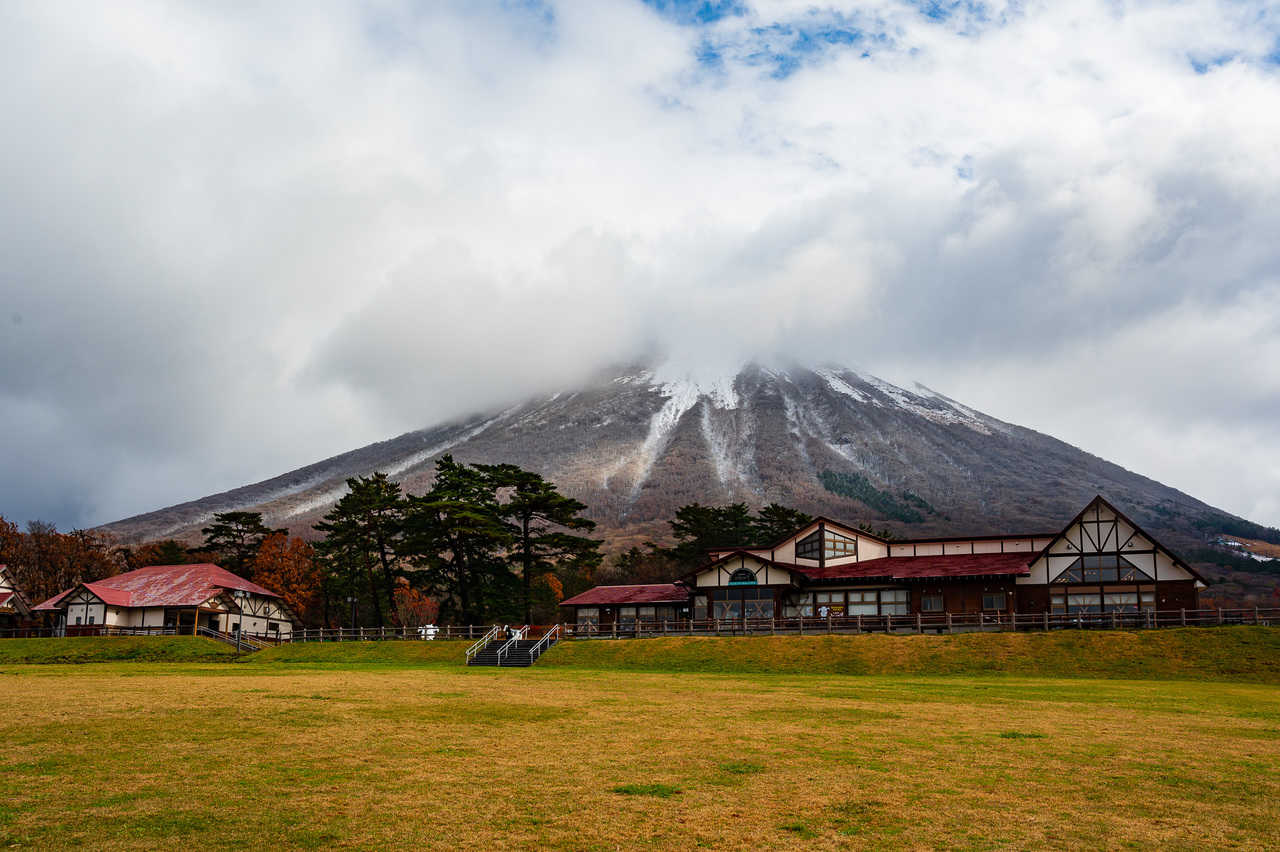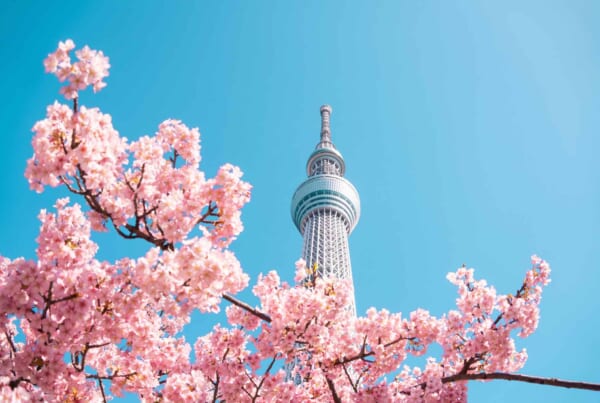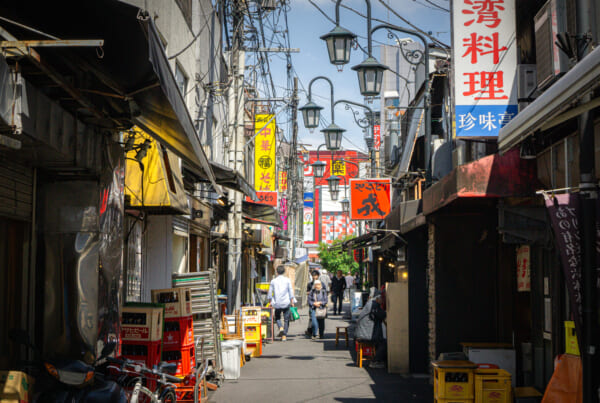With steady rain already falling outside of our hotel in Yonago, we thought it best to try to alter our plans for the day. This morning, we were riding a chartered taxi van up the slopes of Mt. Daisen, on our way to Daisenji, the famous temple nestled in its forest. Since our other destination for the day was a museum, we thought we might rearrange our schedule to visit the museum first and hope the rain would stop for a more pleasant hike around the temple in the afternoon. Seki-san was on the phone with the temple staff, and when he finished, he delivered the bad news. “It’s snowing at Daisenji,” he told us. “And it will probably snow all day long.”
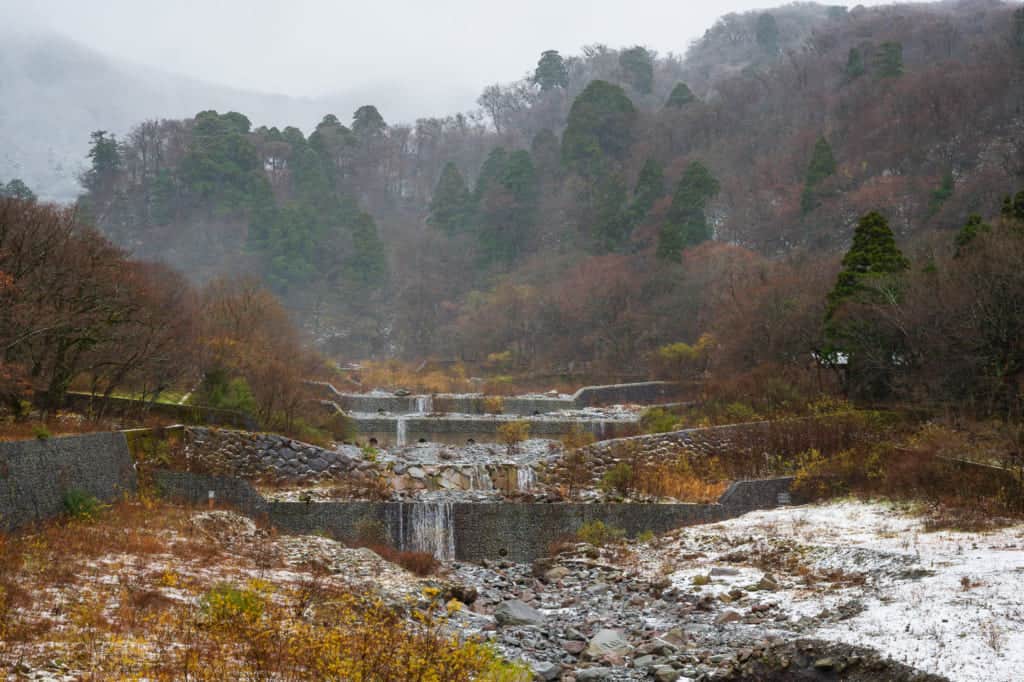
Daisen-ji: The former Shugendo Stronghold of the West
Snow on Mt. Daisen is not an unusual thing in the winter months, but it had been reasonably warm for the past few days, not nearly cold enough for us to worry about snow. If it was going to snow all day, there was no reason to alter our plans, so up to the temple, we went. Our skillful driver maneuvered us carefully up the slick slopes, dropping us off at the flight of stairs leading up to the first wooden gate.
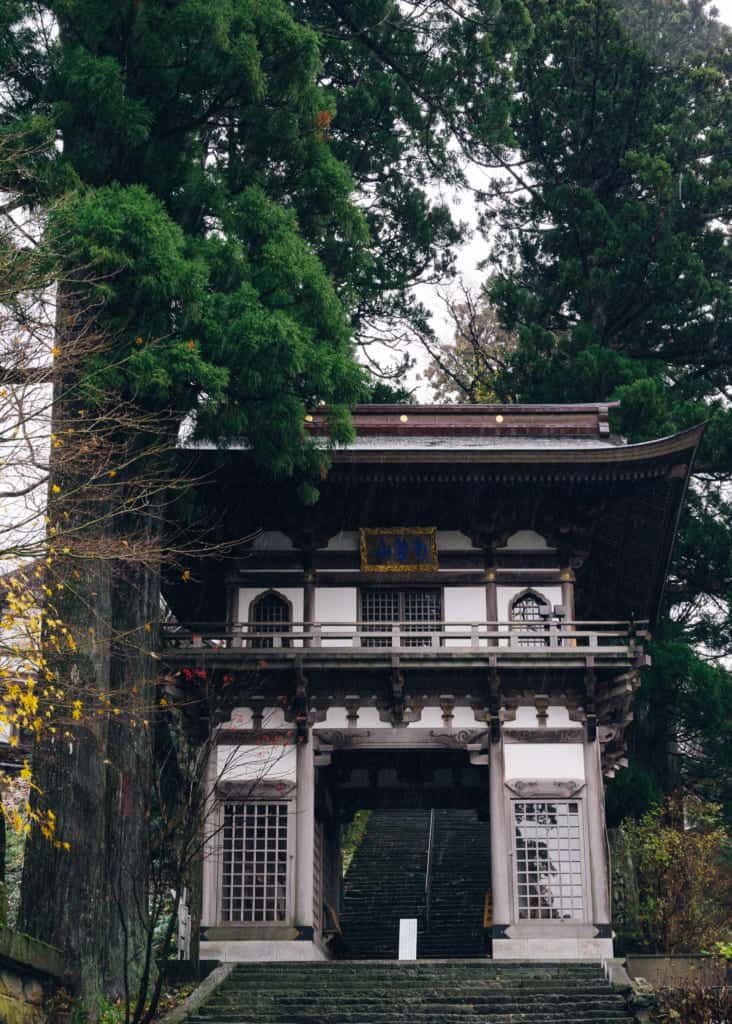
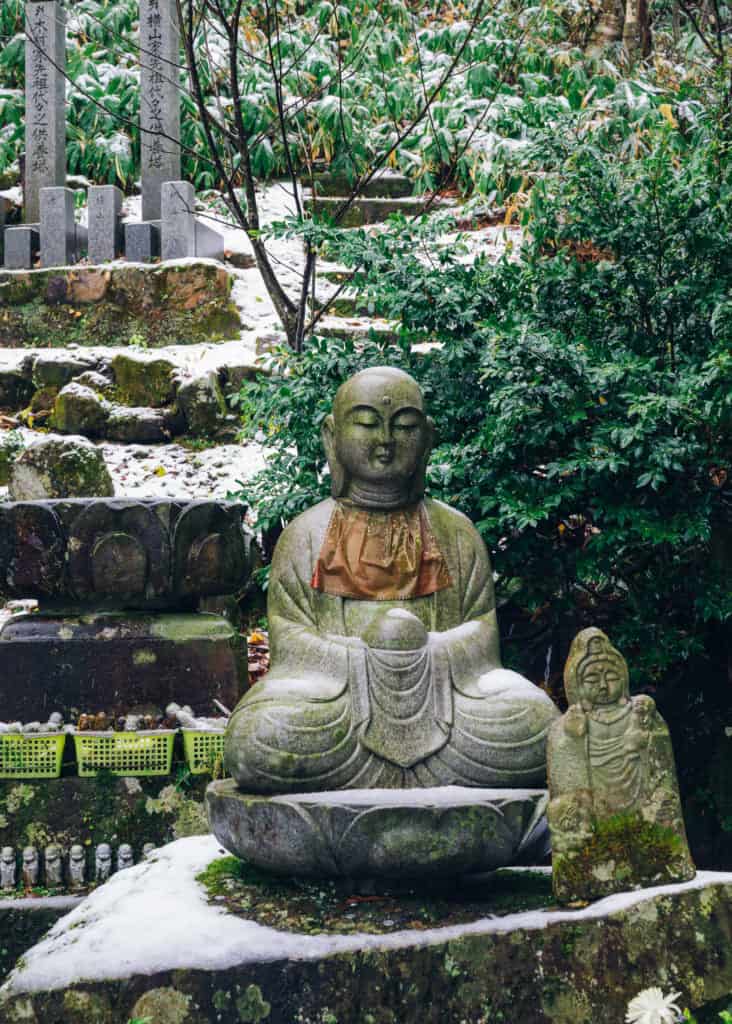
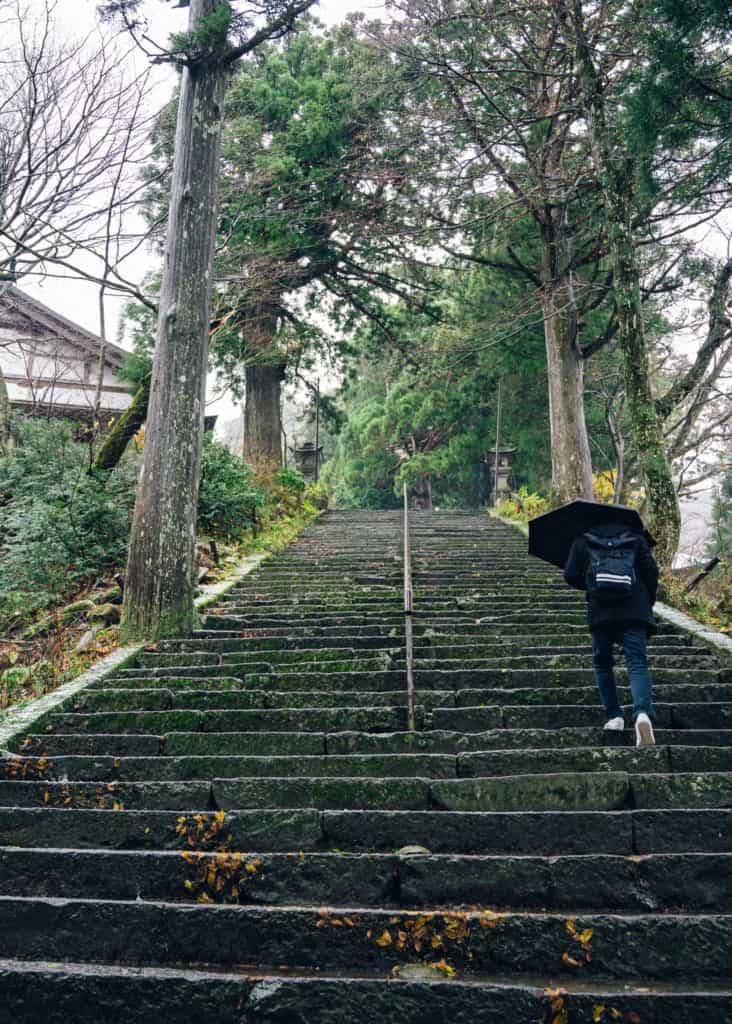
Mt. Daisen rises 1729 meters above western Tottori Prefecture and is as recognizable a landmark in these parts as Mt. Fuji is in eastern Japan. Like Fuji-san, it is also a volcanic mountain with an elegant silhouette when viewed from certain angles. Daisenji Temple is the trailhead for Mt. Daisen, whose summit is made up of a ridge with several sharp peaks, the highest accessible one being Misen at 1709 meters. In the non-snowy months, you can hike 4 km from the temple to Misen Peak, though it takes about 3 hours and is mostly stairs, so it is not for the faint of heart. During winter, Mt. Daisen has some of the best ski areas in Western Japan, not far from the temple.
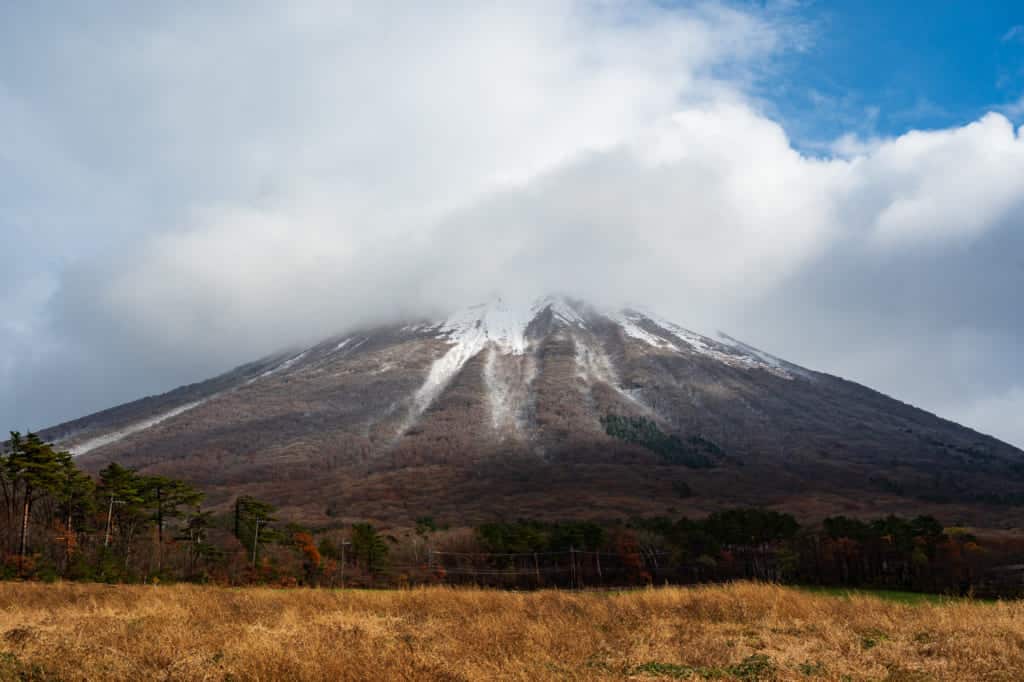
The almost mystic appeal of Mt. Daisen has existed for over a millennium, when the first temples were built there by practitioners of Shugendo, a mixture of Buddhism, Shinto, and animistic religions. At one time, about 160 temples with 3,000 “warrior monks” were part of the Daisenji complex, a force large enough to make the Meiji government uncomfortable enough to force its closure in 1875. Nearly 3 decades later, it was allowed to reopen, but only identifying as a Buddhist temple.
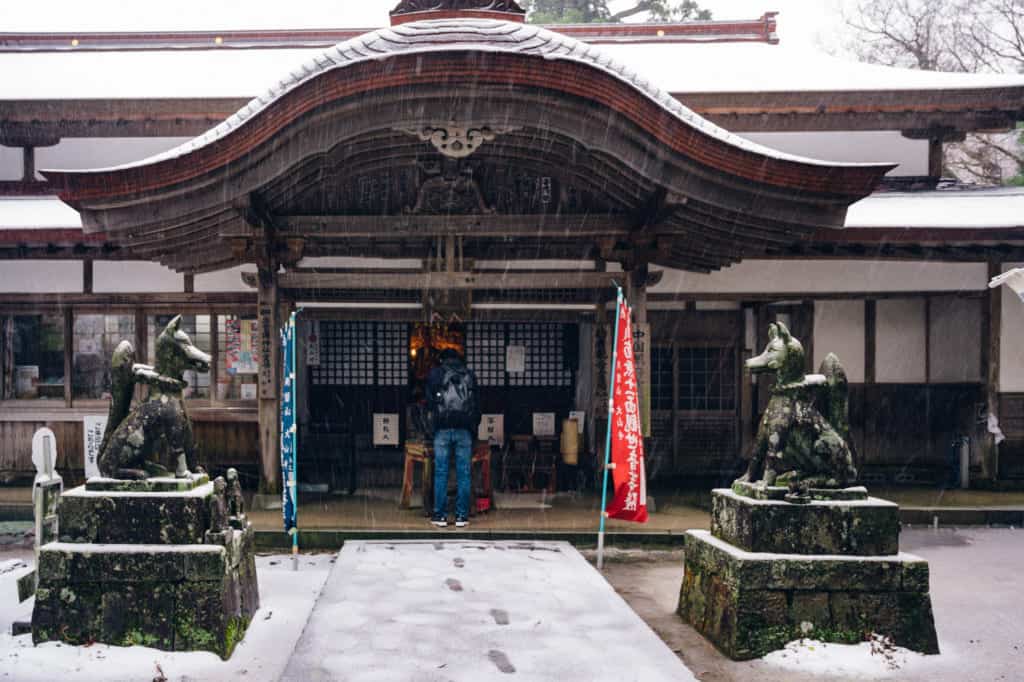
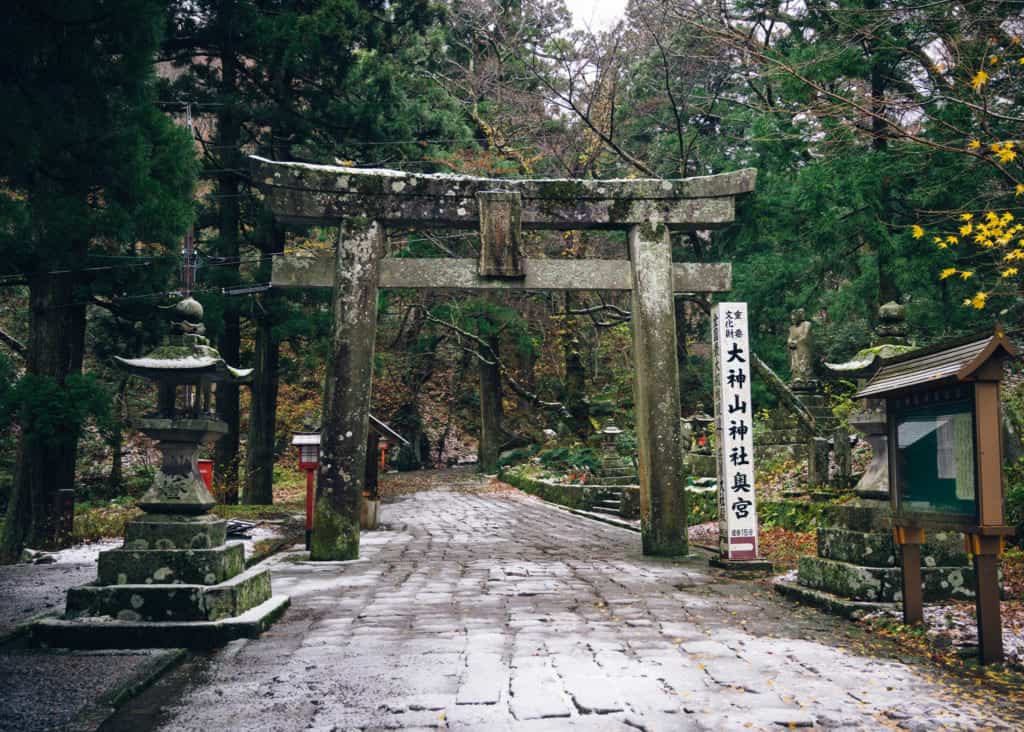
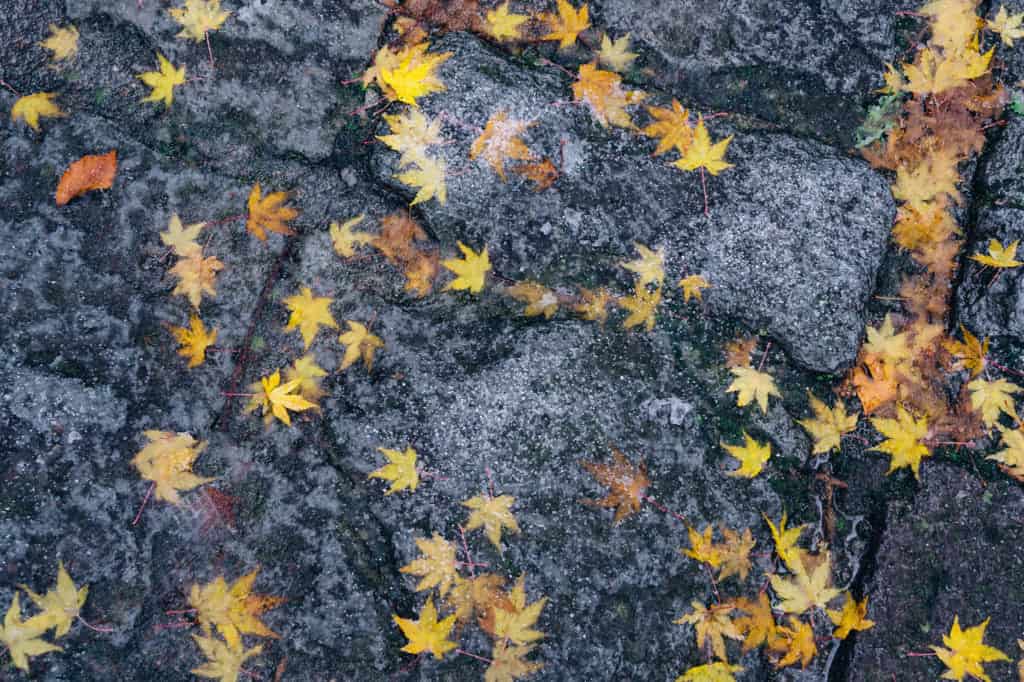
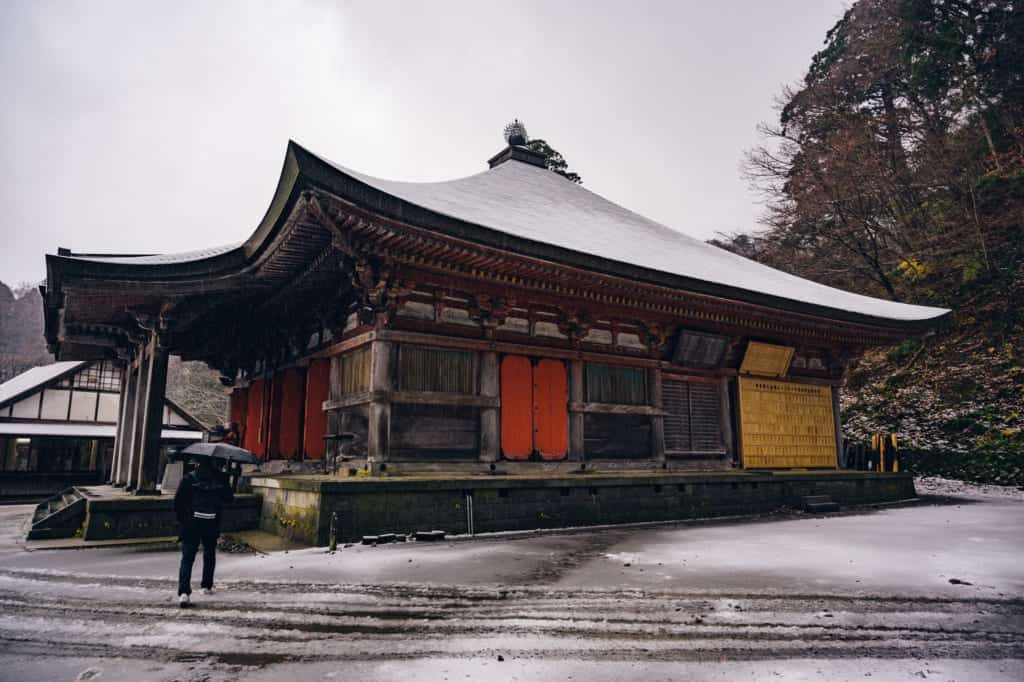
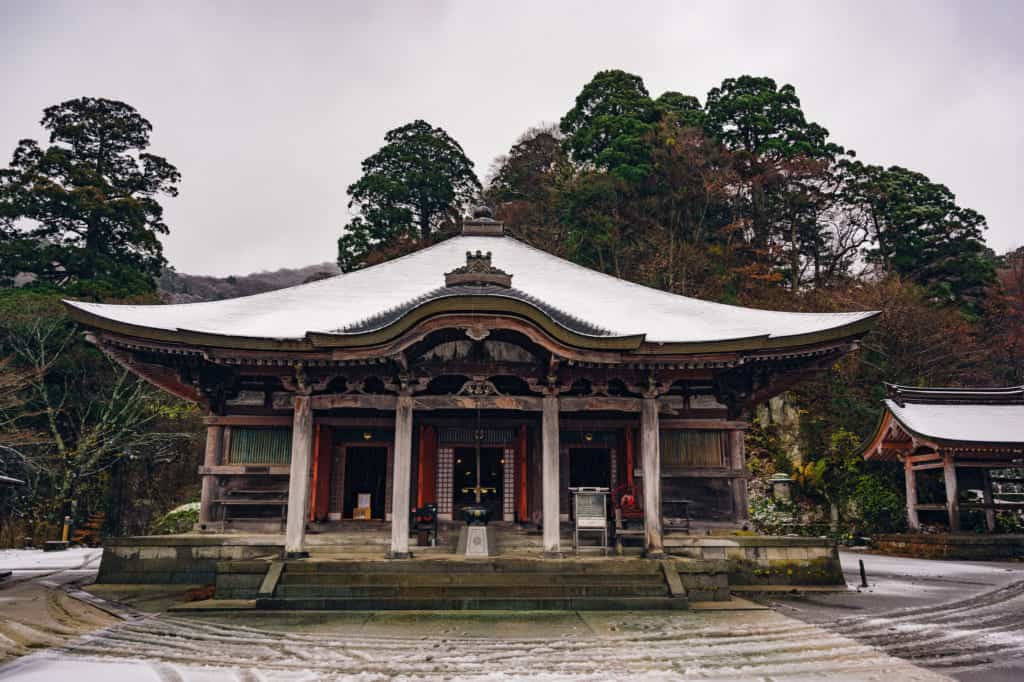
Today, the “snow” falling on Daisenji was somewhere between sleet and hail – wet and chunky – making the stairs a slippery hazard. We climbed each step deliberately, making sure each foot was firmly placed. Finally reaching the top, we continued to the main temple to meet one of the priests. Greeting us warmly, he gave us a brief history of the temple before advising us not to proceed with our plans to hike to the upper Ogamiyama Shrine at the top of the complex because of the weather conditions. It was wise, albeit a bit disappointing counsel which cut our visit short, so we made the slow descent back to the taxi. Inside, we let the heater thaw our frozen fingers, because soon, it would be time for ice cream.
Ice Cream and Milk Shabu Shabu at “The Home of Milk”
It’s hard to imagine coming down from the snow to enjoy an ice cream cone, but Daisen is home to Milk no Sato, where the ice cream is so fresh and delicious, it would be downright foolish to skip it, no matter the weather outside. Milk no Sato roughly translates to “Home of Milk,” which for many residents of western Japan is the literal truth. Milk no Sato is run by the company which produces Shirobara brand milk, well known in west Japan, and a staple of school lunches in Tottori Prefecture.
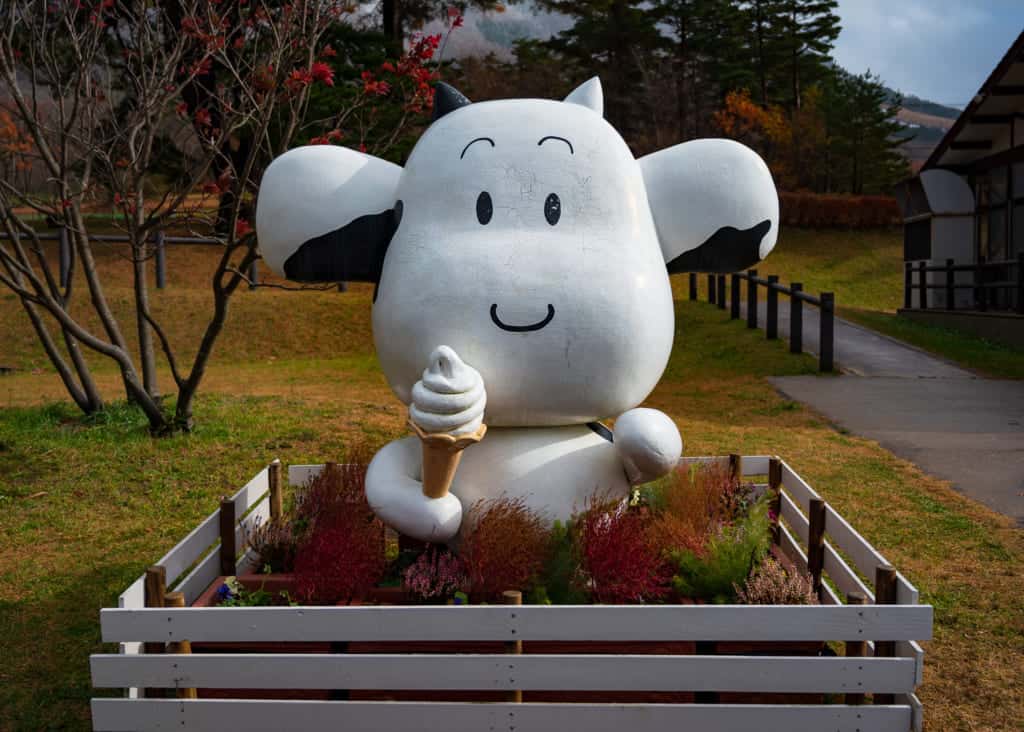
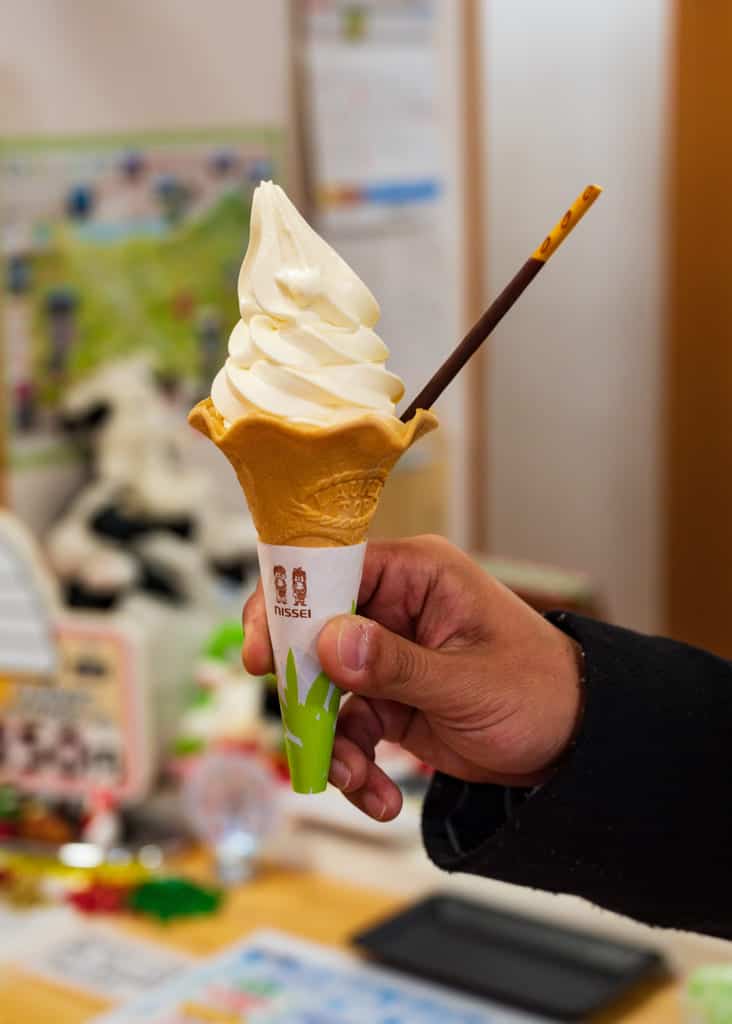
Originally built as a dairy farm, the Daisen Dairy and Farming Cooperative soon realized that many tourists were actually interested in visiting the farm as part of their trip to Daisen. For health reasons, it’s not a good idea to mix tourism with a working dairy farm, so the dairy production was moved, and Milk no Sato remained as an attraction to introduce the dairy industry to tourists. The primary business of the farm today is to help the Co-op’s farmers breed, birth, and raise dairy cows to maturity, at which point they are returned to their home farms permanently.
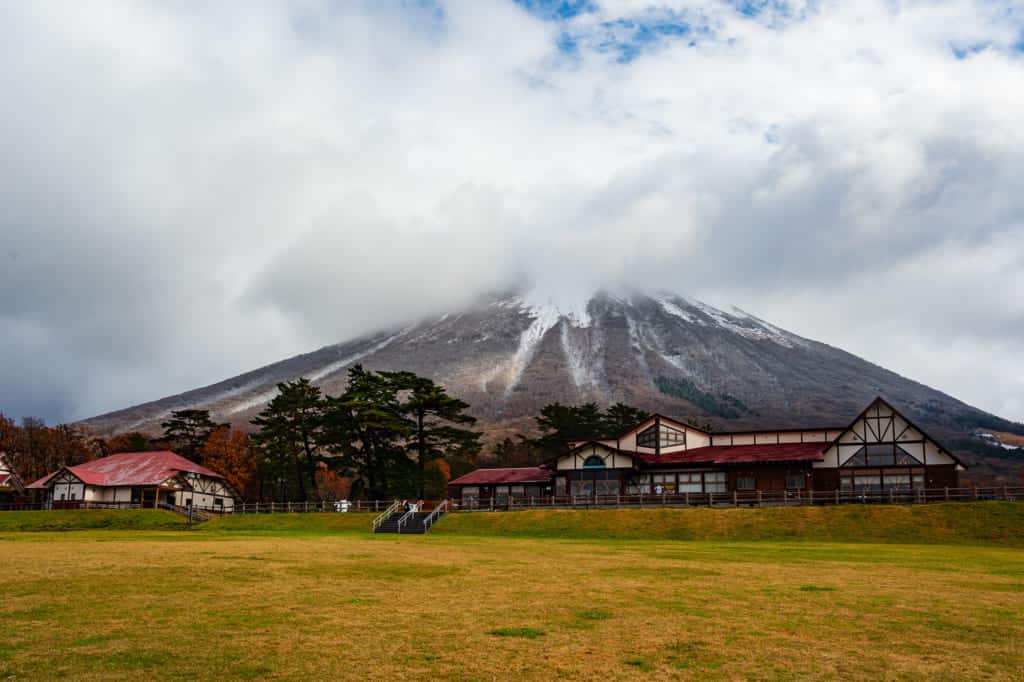
Milk no Sato (website in Japanese) has a gift shop selling dairy-related foods and snacks, including the famous ice cream. Many people stop here to enjoy the ice cream along with the stunning view of Mt. Daisen or down to the Japan Sea available from here. There are activities such as butter or ice cream making, sausage making, or milking a cow (some activities are only available on specific days and require a reservation). It also has a restaurant serving meals made with local Tottori ingredients and a BBQ restaurant, in which we were going to savor a meal particular to Milk no Sato, Milk shabu shabu.
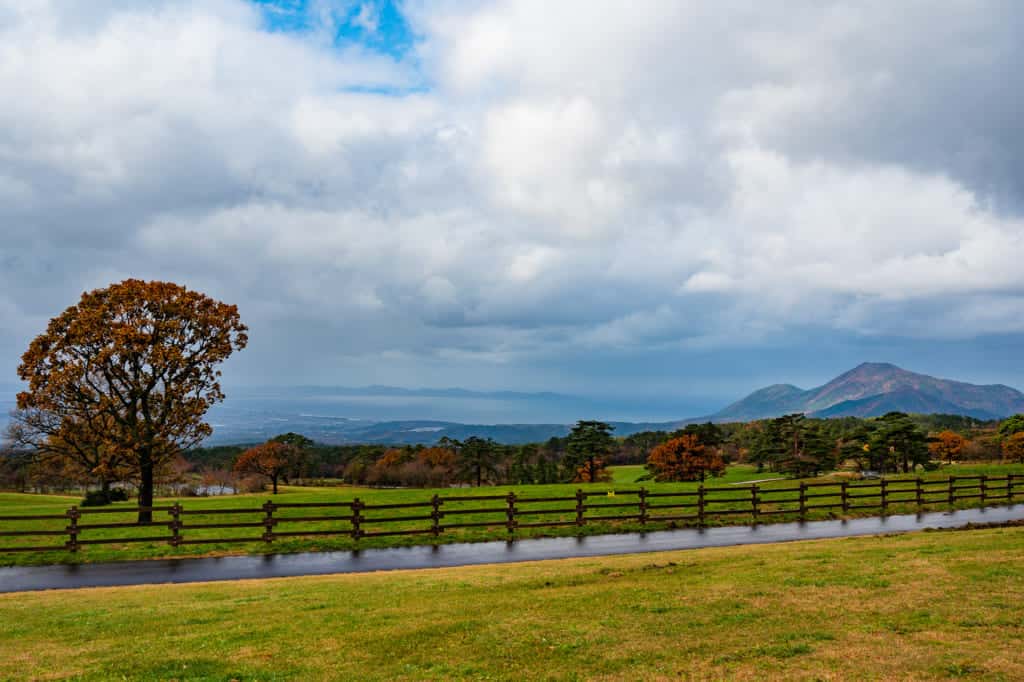
If you are familiar with shabu shabu, you already know that it is usually a hot pot containing a broth in which you cook meat and vegetables and serve yourself like a soup. Here, however, instead of broth, you get a pot of hot milk, which is also seasoned to give the ingredients a flavor other than just milk. The Milk shabu shabu comes with a huge serving of Tottori beef and the typical shabu shabu vegetables: cabbage, shiitake mushrooms, sliced carrots, and Japanese nagainegi (large scallions).
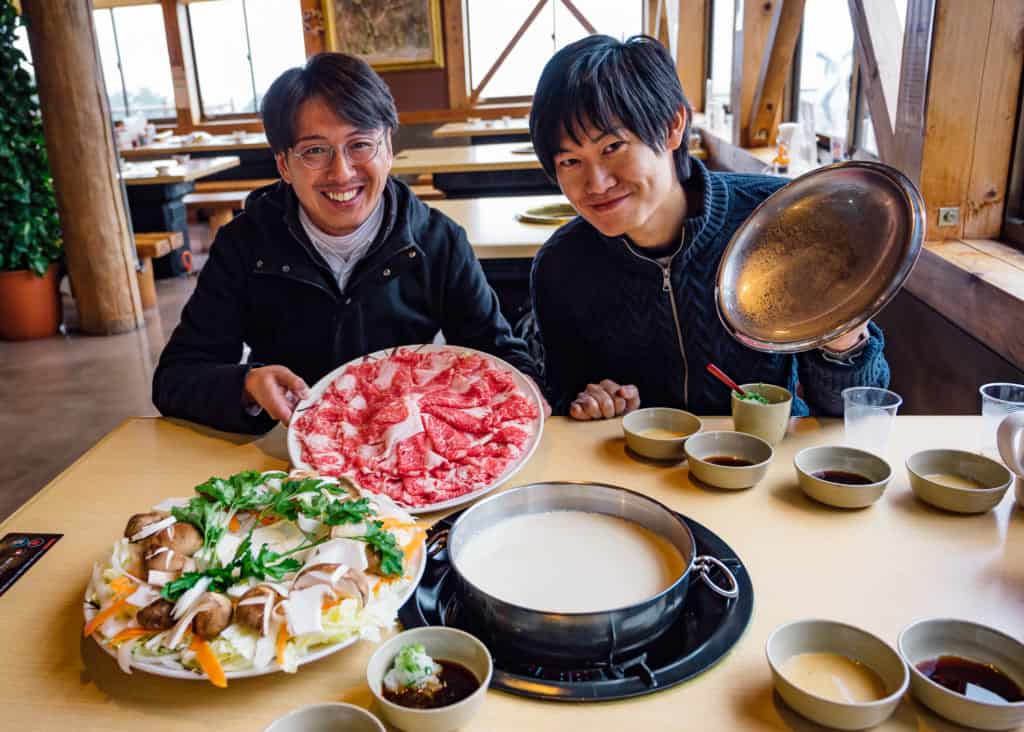
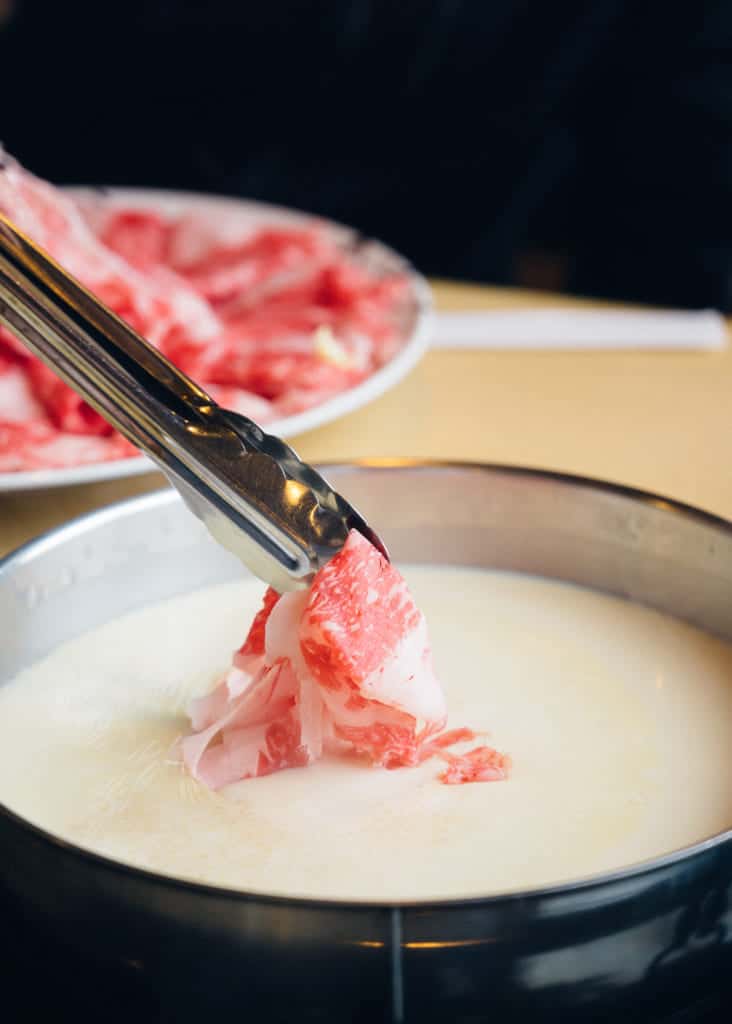
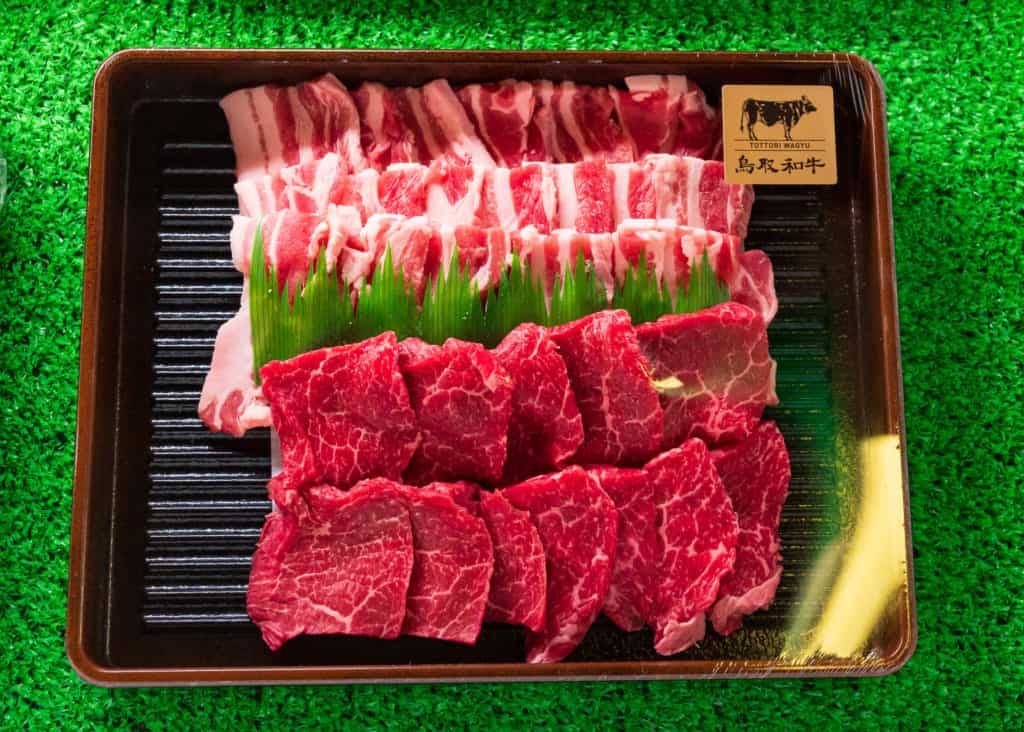
The beef cooks quickly to tender perfection in the hot milk, after which you can dip it in your choice of sauces for added flavor. The vegetables simmer in the broth as well, and you can scoop some out whenever you are ready to eat them. I can’t say for sure if the milk made the rest of the ingredients more delicious, but I can say that the whole meal was a satisfying way to warm up after a snowy walk at Daisenji, followed by an ice cream snack.
Milk no Sato is closed during the winter months, but don’t worry – you can enjoy milk shabu shabu any time during the rest of the year.
Shoji Ueda Museum of Photography
Much like his work, the external appearance of photographer Shoji Ueda’s museum, designed by award-winning architect Shin Takamatsu, appears minimalistic. Only from the inside, where three galleries of Ueda’s work are complemented by the Daisen landscapes, can you truly appreciate the design of this modern building.
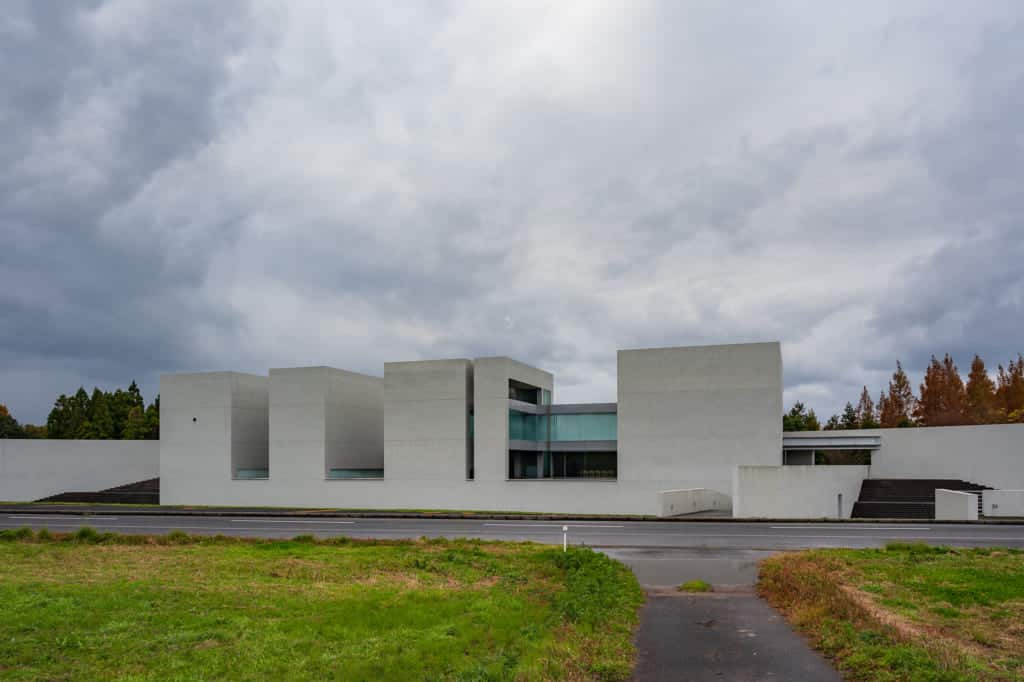
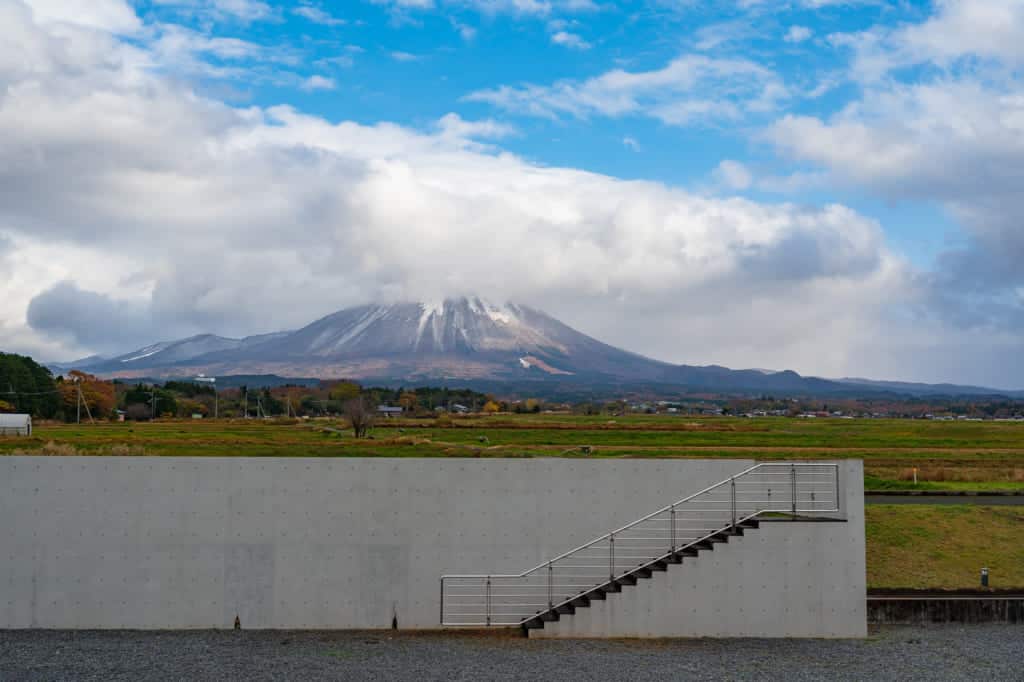
Shoji Ueda was born in 1913 in Sakaiminato, a birthplace shared with another famous Japanese artist, Mizuki Shigeru, the yokai illustrator. From the age of 16, when he received his first camera, Ueda was fascinated with the still image. He founded a local camera club with 3 other photographers as a teenager. Ueda eventually found interest in his work from several exhibitions held in Tokyo, where he attended university, though he opened his own studio back in Sakaiminato. Ueda had a great love for the area he grew up in, and nearly all of his famous work was shot in Tottori or its neighboring prefectures. In particular, Ueda is known for black and white portraits shot in the Tottori Sand Dunes, a mixture of realism and surrealism that still fascinates audiences to this day.
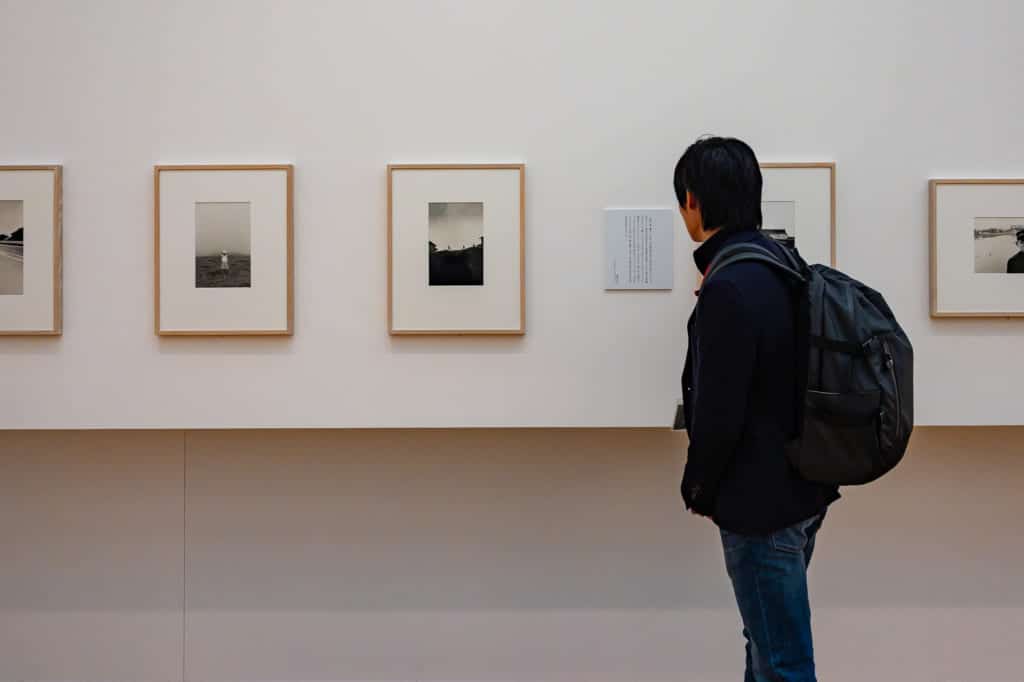
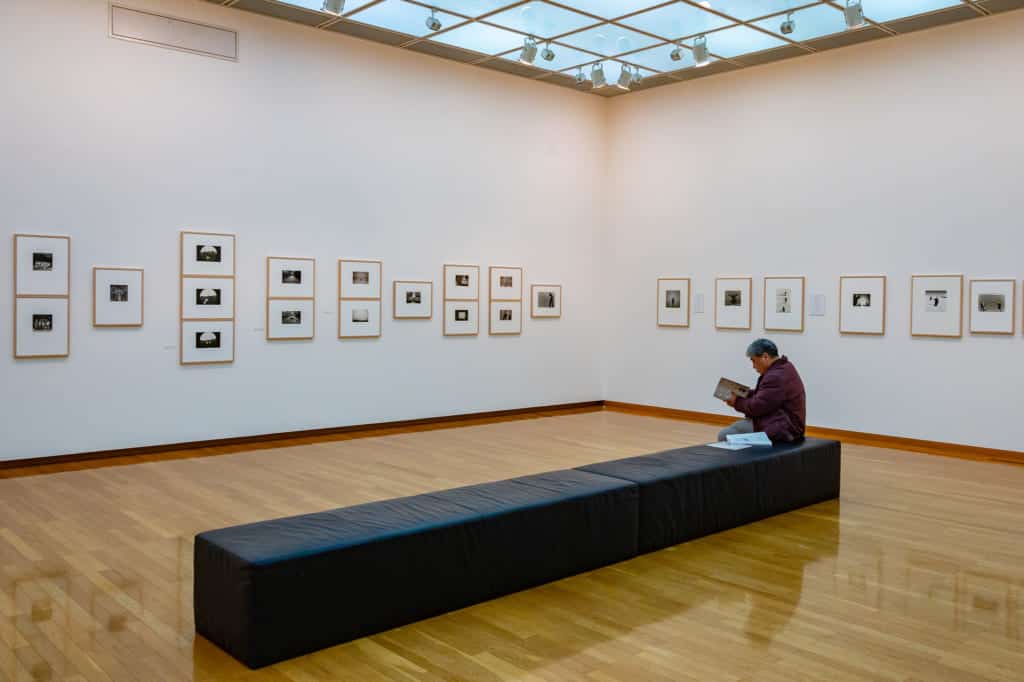
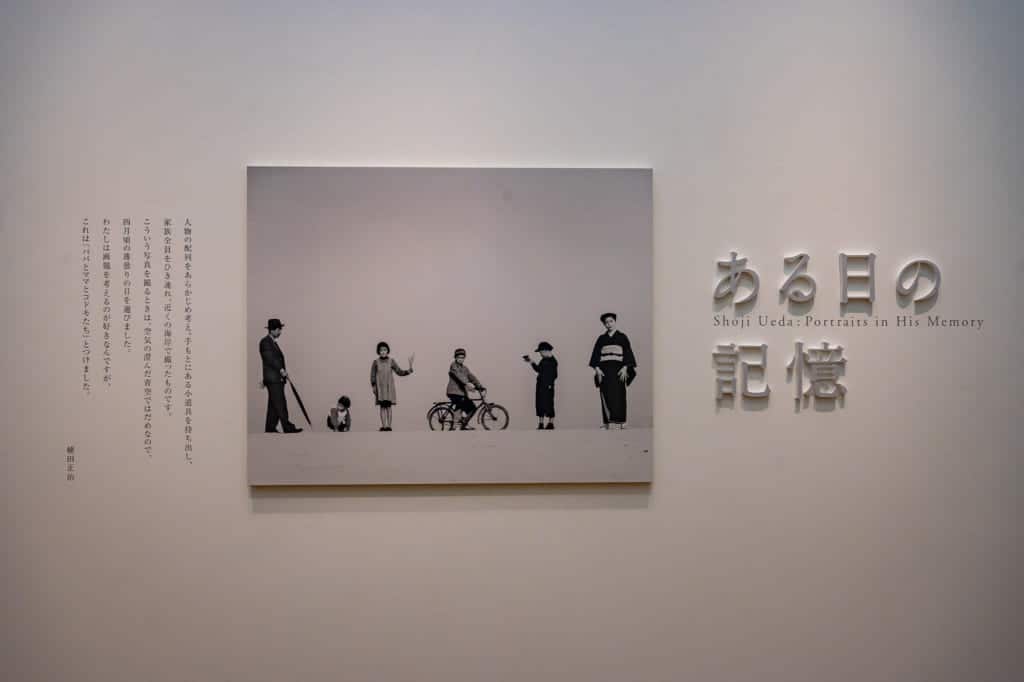
The stark minimalism and human emotion of Ueda’s work stand in contrast to the views of the scenery from his namesake museum. The location of the museum was selected based on the surrounding landscapes. The galleries of the museum are separated by open spaces with still ponds, within which you can see the grandeur of Mt. Daisen and its reflection on the water. Though the top of Mt. Daisen was obscured by clouds the day we visited, if anything, it only added to the dramatic view. Sitting in front of the window, I took a deep breath, as if I was breathing in the landscape framed before me.
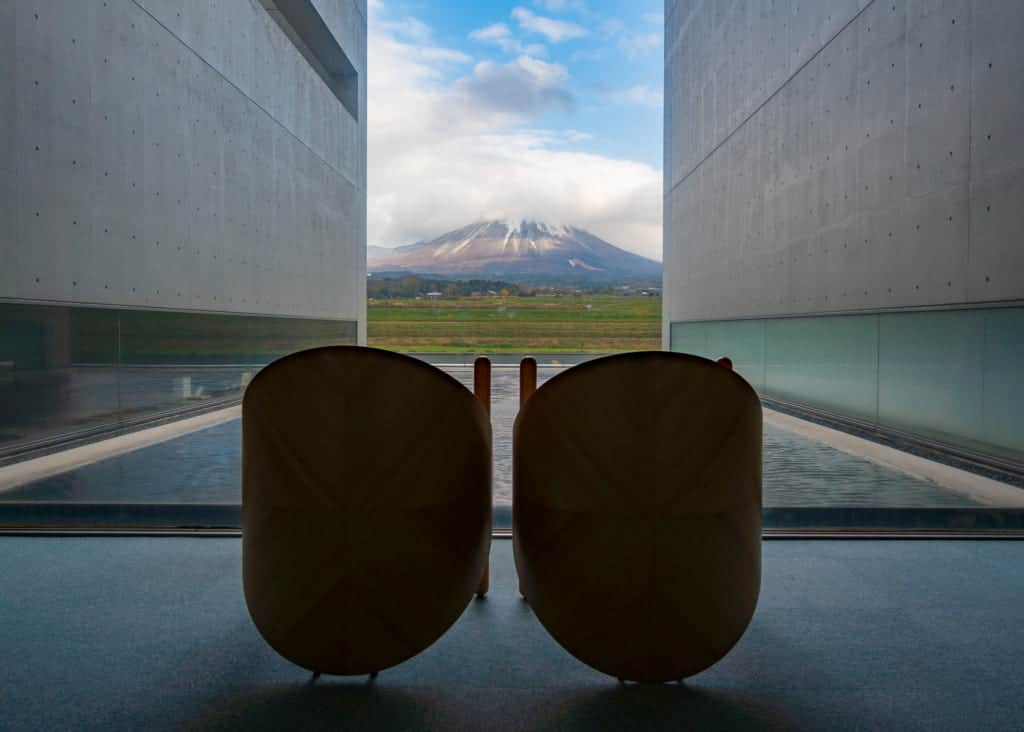
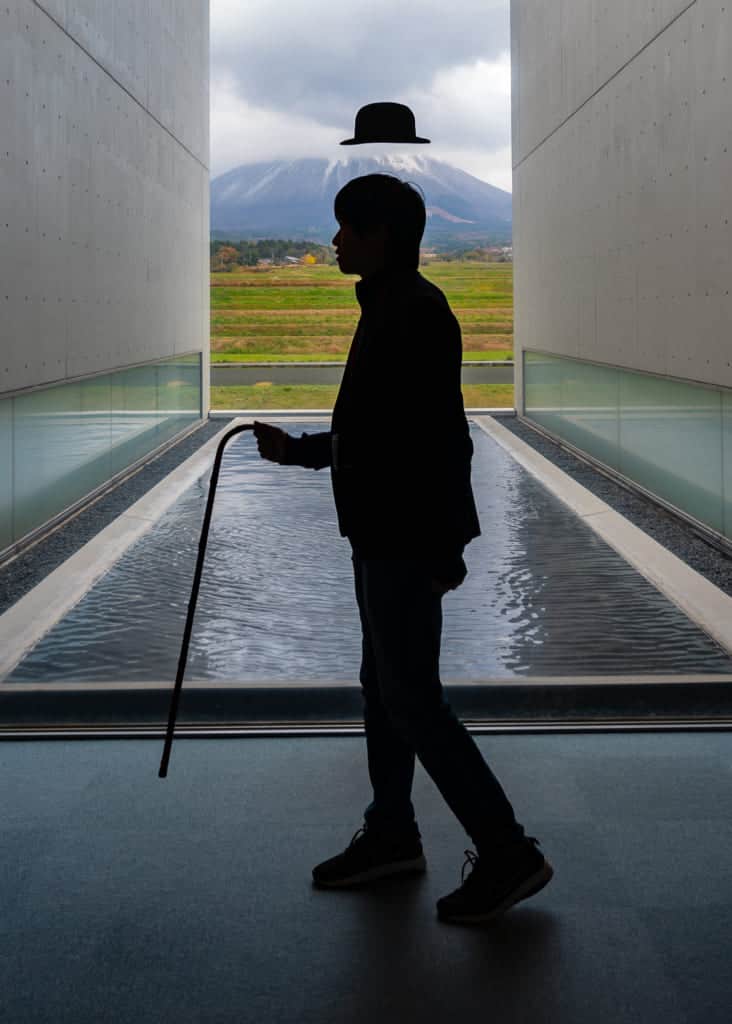
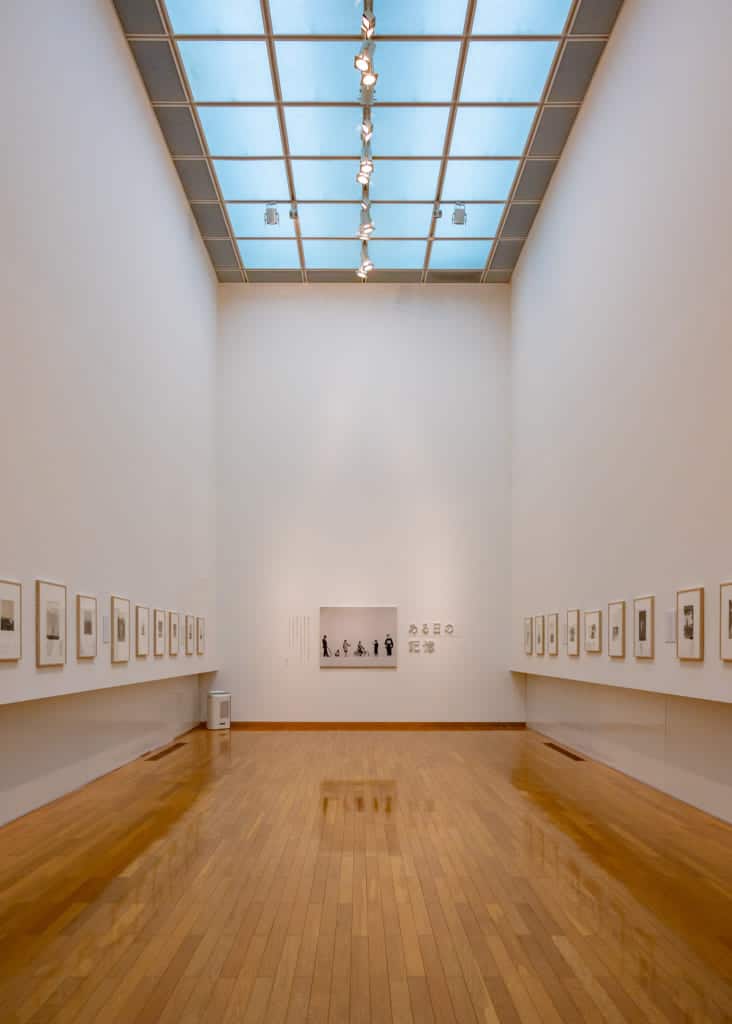
Whether or not you love museums should not be a deciding factor in visiting this amazing place. As a photographer, I found Ueda’s work inspiring, but beyond that, the building is designed in a way to augment the view of Mt. Daisen, not a small feat for a mountain so grand.
Note: Photography is not allowed in the photo galleries, but the Shoji Ueda Museum of Photography graciously made an exception for me to include images from the galleries in this article.
Where To Stay and How To Get Around the Daisen Area
There are many choices for accommodations around Daisen, from Yonago city hotels such as the Harvest Inn Yonago adjacent to the train station to the beachfront hotels and ryokan of Kaike Onsen. But if you want to stay on the mountain, most visitors opt for the Royal Hotel Daisen. With either a mountain or seaside view from your room and proximity to many of Daisen’s attractions, the Royal Hotel Daisen gets many visitors. Though a bit dated in decor, the service here remains impeccable, and the rooms, by Japanese standards, are enormous.
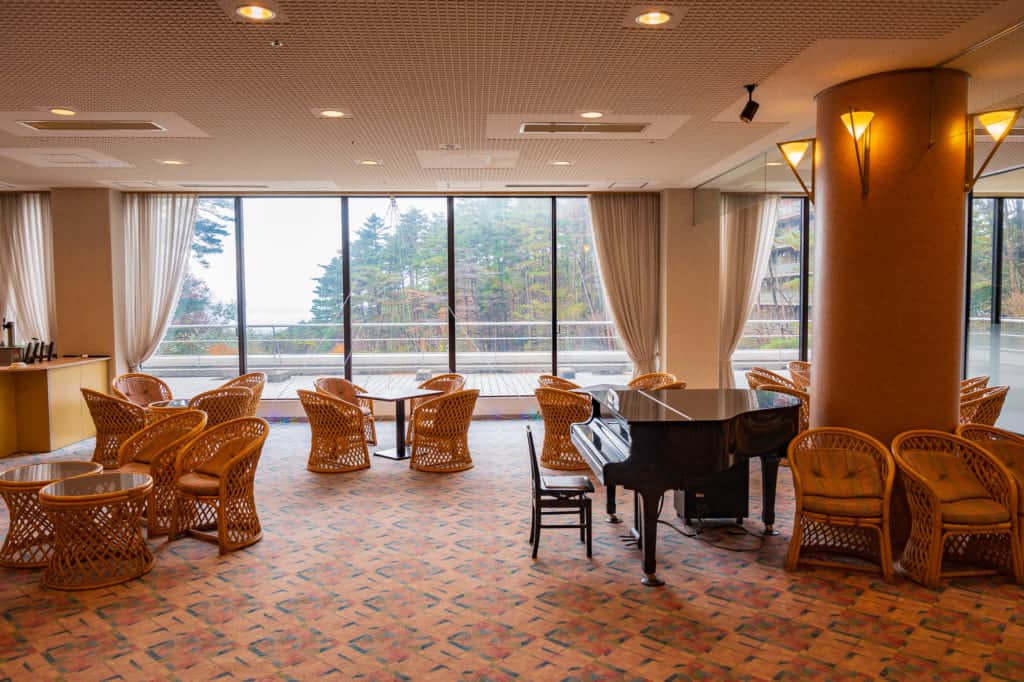
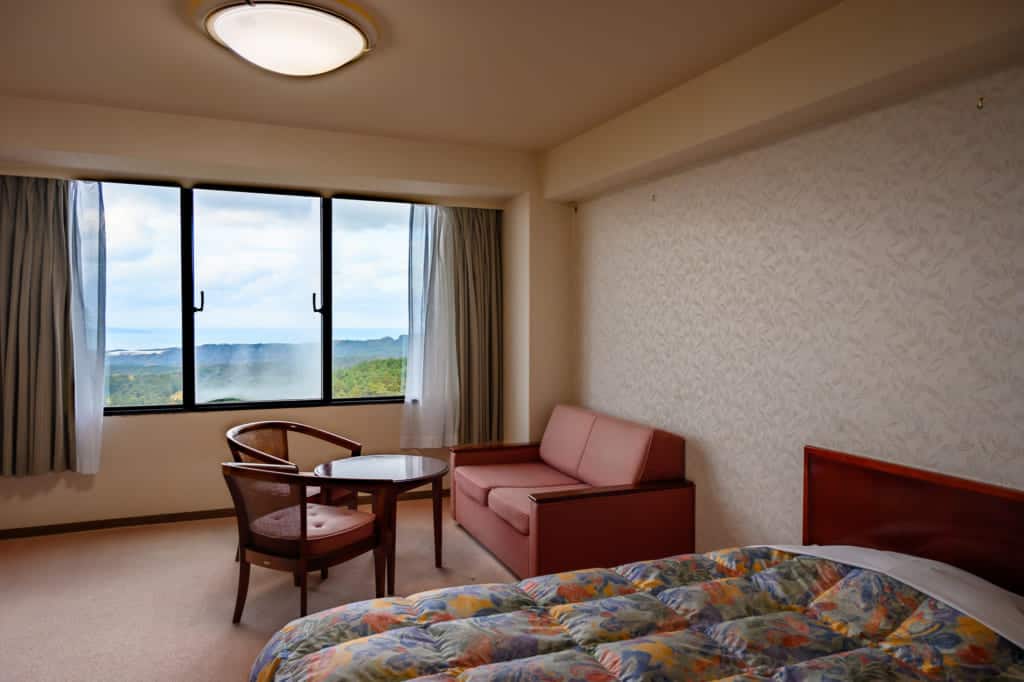
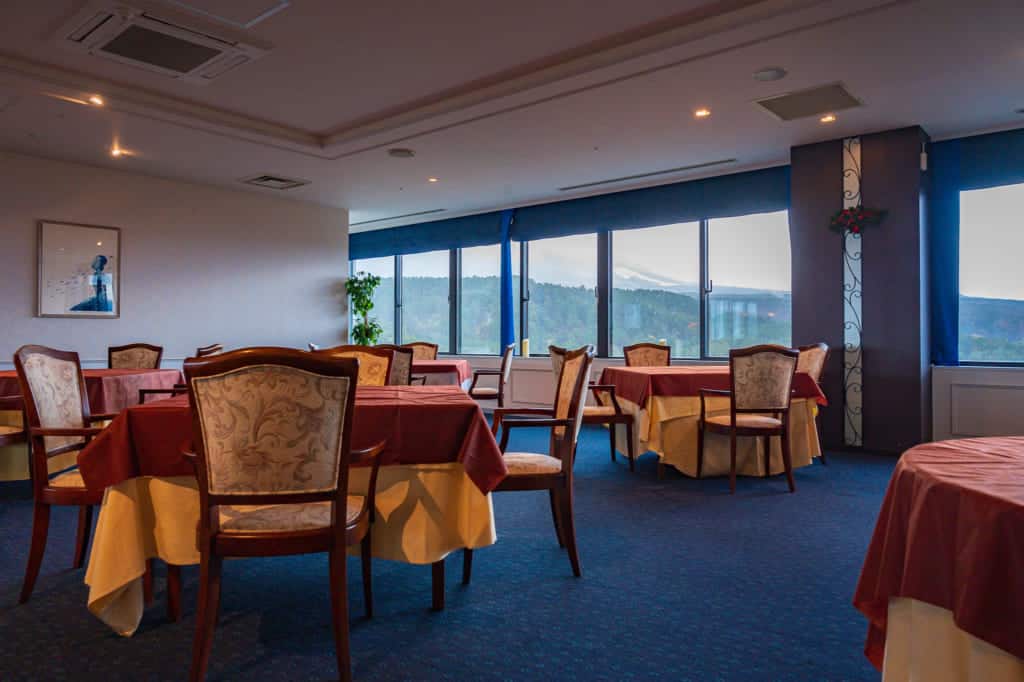
There are several options to get around Daisen, including the Daisen Loop Bus, which stops at all the attractions mentioned in this article as well as several others, plus popular hotels. You can take a taxi to individual locations, or you can charter a taxi for a tour, which we have a great tip to save you a lot of money.
Transportation Secret Tip: Chartered Taxi Tours
Here is an incredible money-saving tip for foreign passport holders traveling as a family or group. You can book a chartered taxi or taxi van on 8 different course options at a savings of 60% or more! As an example, a 5-hour tour consisting of 5 Daisen area attractions would typically cost a group of 4 people about 31,000 yen, but you can book it as a foreign tourist for 12,000 yen. For a group of 9 in a larger vehicle, the regular price is 43,000 yen, but the discount price is 16,000. For the convenience of having your own transportation and the cost per person, this deal is hard to beat.
You can view information about the destinations on the Yonago website, but the special fare is not displayed as it is only available to foreign passport holders. Just keep in mind the price will be at least 60% less than what is listed. You can either call the company to reserve a taxi using the Interpretation center number (092-687-8008 within Japan or +81-92-687-8008 from an International number) or visit the Yonago-City Tourism Information center at Yonago station, and they will help you book it.
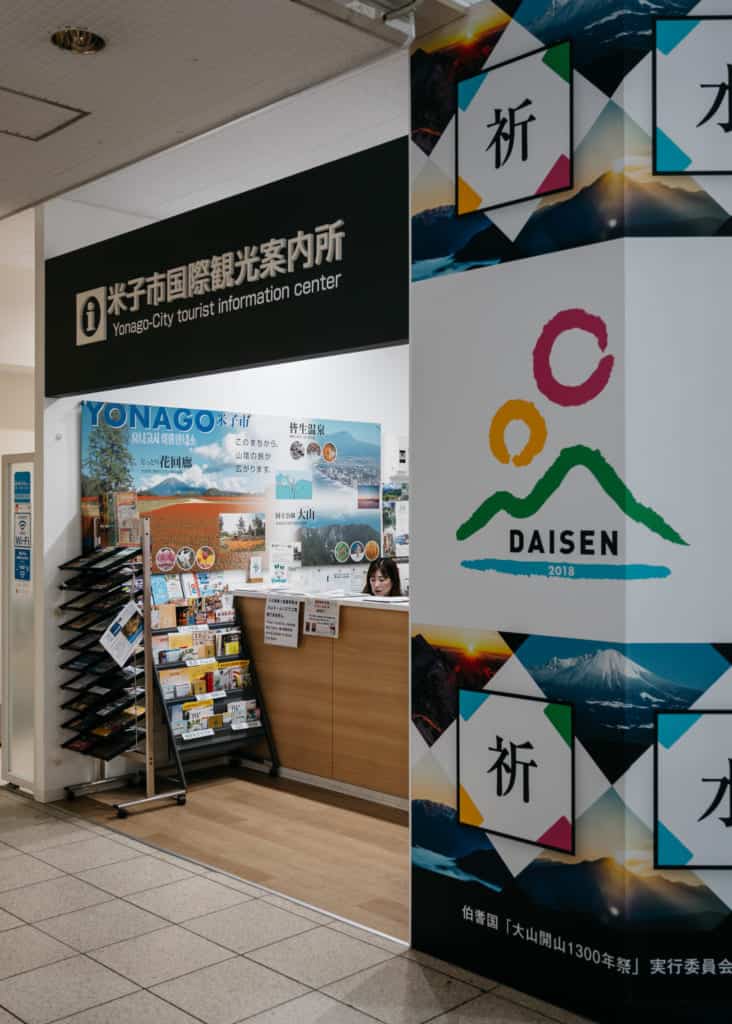
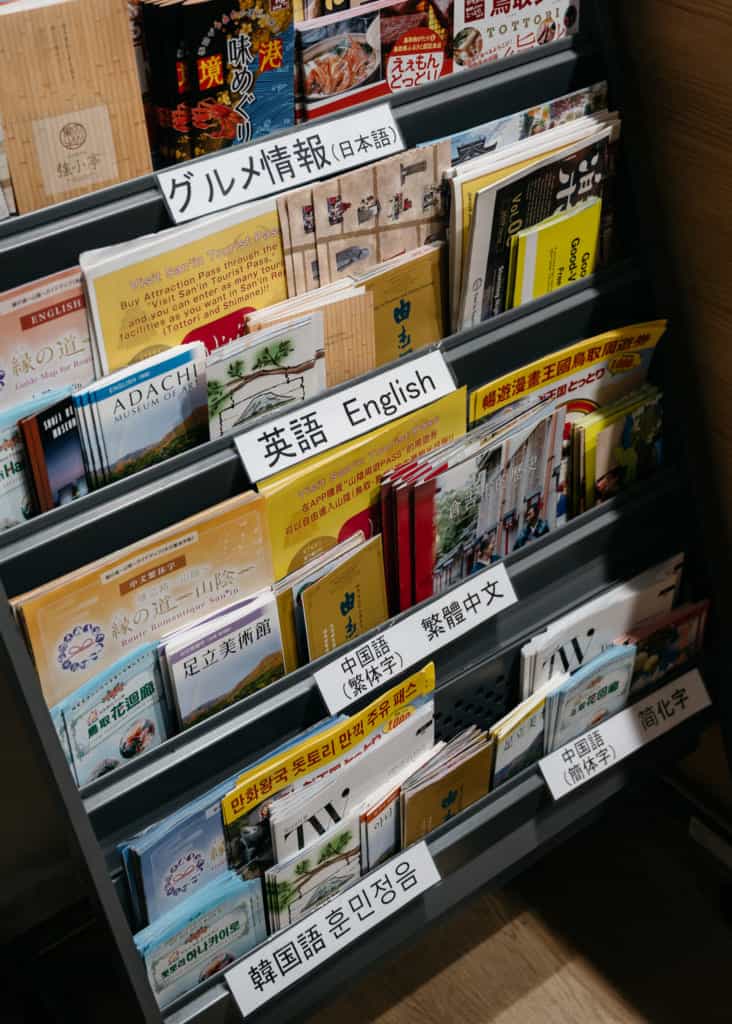
You can reach Yonago and Daisen as I did, as part of a multi-day adventure from Hiroshima by bus, also visiting Izumo Taisha Grand Shrine and Matsue City with its iconic castle. The special bus fare to Matsue from Hiroshima is just 500 yen for foreign tourists, but if you prefer to travel directly between Yonago and Hiroshima instead, that bus fare is also discounted at just 2,000 yen. Yonago also has an airport which has convenient connections to major Japanese and international cities, including Tokyo.
Tonight, we return to Hiroshima by inter-city bus where I will begin the last leg of my adventure tomorrow, starting with an island in the Seto Inland Sea home to a population of rabbit inhabitants!
Sponsored by Chugoku Region Tourism Promotion Association / Chugoku District Transport Bureau


